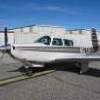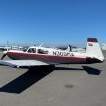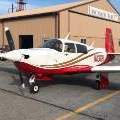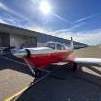Search the Community
Showing results for 'concentrator'.
-
I've been flying my new to me 1978 M20J for a few months now. I recently purchased a inogen G5 oxygen concentrator to increase comfort flying at and above 10k feet. My mooney has a 12v electrical system so I figured I could just plug it into the cigar lighter in the aircraft with the adapter for cars. Tom Laux of Windblade suggested that if I have >7.5A on the capacity plug, then it should be no problem. I reviewed the electrical diagram (http://mooney.free.fr/Manuels M20J/M20J/Mooney Service Manuel M20J Vol. 2 of 2.pdf page 4 for my s/n)and saw it is on the 10A circuit breaker (shared with ignition) and didn't see any fuses depicted (did I just miss it?). During my first two flights with the G5 starting fully charged, the system successfully maintained 100% charge from the aircraft while running on the max flowrate. On my third flight, I started with the unit at ~80% state of charge before plugging it in. After a few seconds the device lost power, and I plugged it into the other socket which had the same result. I dug around behind the panel and found a 5A fuse inline with the socket, which would make sense given my experience. I was surprised to find this given I had not found it on the service manual schematic. In the meantime, I intend to replace it with another 5A fuse, but I am curious for input from others as to why this fuse would be there if it wasn't in the schematic? I would love to swap it out for 7.5A or 10A fuse assuming the wiring and other systems are sized to handle that current draw. Does anyone have any insight they can offer?
-
Before this thread is too old... Let's talk about oxygen concentrators. Do they introduce anything that could be hazardous as an aviator? The documentation I can find says they are not actually oxygen concentrators, they are nitrogen excluders, using zeolite to concentrate and exclude nitrogen. This means the concentration of other elements is much higher than normal. Below is a chart that shows this for 90% O2 and a 'perfect' concentrator that removes 100% of the nitrogen. From reading https://pmc.ncbi.nlm.nih.gov/articles/PMC9646629/ they say that argon starts to be a problem at concentrations of 33%, so I think this is not a hazard. I'm going to assume the other elements/molecules are equally nonhazardous at these increases in concentration. I have not done any thinking about water yet but as a pure concentration of normal atmospheric elements, I don't think it's hazardous. Gas concentrations with an oxygen concentrator: Normal Atmosphere 90% O2 concentration "Perfect" oxygen concentrator Nitrogen 78.07388% 5.75902% 0.00000% Oxygen 20.94836% 90.03845% 95.54066% Argon 0.93393% 4.01412% 4.25943% Carbon dioxide[6] 0.04120% 0.17707% 0.18789% Neon 0.00182% 0.00782% 0.00830% Helium 0.00052% 0.00225% 0.00239% Methane[7] 0.00018% 0.00077% 0.00082% Krypton 0.00011% 0.00049% 0.00052%
-
I wonder the same. I was puzzled by Don's experience. I almost didn't get the O2D2, but am happy I did. Interestingly, I believe I have the same (or similar) altitude-compensating regulator (IIUC) in the factory system in the Acclaim. Mountain High's guy (Eric, I think, whoever is the main person who helps you select a product) said the system will actually provide too *high* a pressure and, to get it to work correctly, I needed to inline a regulator upstream: https://www.mhoxygen.com/product-category/regulators/regulators-reducing-ilr/ So, I suppose the system might not work correctly if the pressure is too high. Though I think in a previous post Don detailed that he worked with the company on this and so presumably this has been tried. It seems plausible that the depth of inhalation could cause this issue, since the puff comes early on. Whereas a continuous flow will give you close to the same mix, except maybe when using a mask. Anyhow, I find my own results vary a lot with breathing technique, either free-flow or O2D2. I get a lot of variability with the cannula, similar to what someone described above, sometimes fine on D5, occasionally needing to switch up to F2. Might be physiologic state that day, who knows. I would have the same problem I think using a cannula with any system. With a mask, it consistently works flawlessly regardless of attention and effort. The real game-changer with the pulse-delivery systems is that it makes fills so infrequent that: 1. you just use oxygen whenever it makes any sense at all (I usually just go D5 on any XC, and always at night) 2. you don't have to plan ahead on fills, which I had to do using the factory system at continuous flow I imagine the concentrator gives a person a similar sense of freedom. An aside: a person above mentioned how hard it is to hold your breath long enough to drop your SaO2 at sea level. That's because your primary respiratory drive (if healthy) is from too much CO2. Less CO2 at altitude makes it easier to not breath enough. Also, fun fact, this is why it's dangerous to hyperventilate prior to a long underwater swim, you can fight your air hunger long enough to pass out from lack of O2. I think we, collectively, may have found a replacement for the "lean of peak" discussion topic
-
This may not be all the parts but I bought and created my own connector/splitter/hoses/cannula setup: RES010TC to connect to the large outlet on the G5/Next Salter 1225 Swiveling O2 Supply tubing connector (Male to Female) If you want to set up for two (2) then add AGISH749 - AG Industries Y adapter for O2 tubing from Amazon ComfortSoft Plus Nasal Cannula w/ 4 ft clear O2 supply tubing Even though you may hear the Rove6/G5/OxyGo Next concentrator pulse when you breathe, I wanted a visual indicator. SP Bel-Art Roto-Flo Polystyrene Flow Indicator for ¼ to ⁵/₁₆ in. I.D. Tubing (H19937-0002): Enema Flow Indicator: Amazon.com: Industrial & Scientific It is a red spinning wheel We fly in the low teens. Works fine.
-
I bought the complete Rove 6 (the latest Inogen) pilot setup from Jon at Pure Medical (888-747-7590) just before the Cheyenne PPP last month. I mentioned Beechtalk and got a $100 discount. Absolute GREAT customer service. He spent a lot of time with me answering questions. I bought the big 16 cell battery because I didn't want to deal with the step-down transformer in the plane. He did include it so I could use it anytime. The big battery is suppose to supply O2 for over 12 hours for 1 user and weighs an additional 1 pound. The pilot pack includes the following: "1 × Pilot Package 16 Cell- New Inogen Rove 6 Pilot Package Portable Oxygen Concentrator- Includes unit 16 cell battery, carrying case, AC/DC chargers, 2- 4' cannula, Y splitter, pulse ox, manual, and 5 year warranty" In using it in a C model at the PPP I just put it in the back seat. After 4 hours of use with 2 people at 10,000 feet, it still had over 4 hours of charge remaining. At setting 4 our O2 saturation levels were over 96%. I'm taking it to Oshkosh this week as a backup.
-
If you read the research paper that CAMI produced (linked earlier), there are two aspects at play for oxygen concentrators and altitude: 1) that at a certain altitude/barometric pressure the FLOW rate declines; and 2) at a certain altitude/barometric pressure the oxygen CONCENTRATION declines. The rate of decline and altitude it starts are unit specific and can NOT be generalized to every concentrator sold. In the absence of testing form a third party (i.e. CAMI), you may only have manufacturer guidelines to assist you in determining where that barometric pressure ceiling exists. BTW, this is also likely the reason that there is a difference in Inogen altitude recommendation based on 1 or 2 users...it's likely not driven by the oxygen concentration output, but rather the flow rate.
-
One big thing I learned from almost three decades' manufacturing medical devices: every body is different. (NOT "everybody," but each and every body reacts slightly differently to the same injury and to the same treatment.) So when it comes to oxygen saturation while flying, get a meter, see where you read and decide if you feel good at that level or if you want higher saturation. There's two ways to quickly raise your O2 sats--descend into thicker air, or get some extra oxygen from somewhere (O2 tank, a disposable bottle, a concentrator, somewhere), and see how much your reading changes and if you feel better; if not enough change, descend. Easy easy, and simple enough for anyone to do. Personally, my C struggles to get high enough for me to start feeling bad. What I used to think was low oxygen headaches after 2-3 hours at 7500-9500 msl went away when I got an in-ear headset . . . .
-
In some cases, I think it does. For example, I think you are prohibited from using a nasal cannula above 18,000' MSL, if that device has been certified for aviation use and has a prohibition against use above 18,000'. This is because the FAA has made the manufacturers prohibit it in order to be certified. The way I see it, that's no different than exceeding VnE or max gross weight. But instead of a cannula, if you literally stick the end of the hose up your nose, as far as I know, that isn't prohibited. Is it a worse solution? Yes. Is it legal? Maybe? Does every product you use have a requirement to be 'certified' or 'allowed' for use in the particular way you are using it in order to be legal? No..... If you want to wear your underwear on the outside of your pants and fly around, I doubt the FAA's complaint would be that you were using your fruit-of-the-looms incorrectly. No matter how much absolutely every one of us wishes you didn't do that. Or make up your own example of something that doesn't have a clearly defined use guideline. What about using your Ferrari gloves for flying, when the manufacturer says "For use only when driving Ferrari automobiles." ? I bet the FAA wouldn't violate anyone for that. But it's closer to the oxygen concentrator example What about using an oxygen concentrator that has been certified for non-aviation purposes? Can you use that? What if it says that it's usable by 2 people up to 10,000' and 1 person up to 14,000', but doesn't explicitly say it's prohibited otherwise? What if it says nothing at all? What if all there is for this is marketing copy but nothing in the manual? Bah... All of this is pretty meaningless. Unless or until there is some sort of problem, pilots are generally free to do what they want. You want to use a concentrator? You want to split it between two of you at 15,000' ? Want to use a pulse oximeter? Unless someone can provide authoritative guidance that says you can't, I say go for it. Please be safe. [citation needed]
-
I would think that a normal SPO2 if it correlates should confirm that oxygen equipment is working as intended in the absence of CO poisoning which could result in falsely elevated SPO2. However the previous general “rules of thumb” that may have applied with other equipment doesn’t necessarily apply to different equipment with potentially different outputs. The big “catch 22” is that oxygen concentrators may have a service ceiling that affects output concentrations, whereas a bottle of aviator grade oxygen is 99.5% + oxygen regardless of altitude. So when you factor in pulse delivery vs constant flow, variability in oxygen concentration, and unknown service ceiling…you have to realize that you’re potentially a test pilot and should test yourself and occupants as well as monitor your SPO2 accordingly. You can’t use the flow rate of on board oxygen as synonymous to a concentrator at altitude. It’s not the same thing. Of course when I’m flying at altitude I’m “titrating to effect” based on pulse ox, as I’m sure we all do these days. It wasn’t that long ago that we didn’t have ubiquitous and accurate ways to monitor oxygen saturation real time and flew based on “rules of thumb”.
-
I think this is a little more nuanced than just flow rate. The 1LPM per every 10,000 feet is a rough rule of thumb and based on aviation grade oxygen equipment. There is a difference in the composition of the output from a bottle of oxygen and an oxygen concentrator (potentially dramatically at altitude). I.e. aviation grade as well as medical grade is 99.5% (or better) pure oxygen. But oxygen concentrators may not be able to provide that above a certain altitude as the partial pressure of oxygen is much lower than sea level. From the study I linked above from CAMI, some of the concentrators they tested reached a certain altitude and dropped the oxygen output quite a bit. Sounds like some of them also started to rise in levels of other noble gases like argon. BTW, argon is inert and non toxic but can displace oxygen in a "confined space" because it is more dense than oxygen This discussion isn’t one of “you can’t do this” or “you shouldn’t do that”. It’s a nuanced discussion of the actual limited data we have pertaining to oxygen concentrators. They aren’t all the same and may not all perform the same at altitude. We need more data to replace the speculation.
-
I reached out to FAA Civil Aerospace Medical Institute (CAMI) and they're looking to see if any recent studies have been performed with modern oxygen concentrators. They sent me a prior study using molecular sieve oxygen concentrators, and the AC on portable oxygen concentrator use in flight (more geared to pax bringing concentrator than pilot use). From their comments: * Generally, 1.5 Liter per min flow rate is only good up to 15,000 feet. 2.0 liter flow is good up to 20,000 feet. You see the connection. 2.5 liters would be required at 25,000 and 2.8 at 28,000. Obviously if you’re over 25,000 feet you would be in a pressurized aircraft (by FAR). And if these are molecular sieves that concentrate the oxygen there is typically an argon build up int stored oxygen (some units are high as 5%. That would account for the variability of the oxygen % levels. But that was with older models…newer ones may be better at scrubbing the argon out. * Questions about the practicality (and regulation) of using portable oxygen (O2) concentrators designed for medical use in general aviation (GA) aircraft have come up a lot lately. It’s questionable as to whether these units can remain efficient in an unpressurized cabin at higher altitudes (~ 10,000 up to 25,000 feet), even with a cranked up O2 flow rate. CAMI tested some portable O2 concentrators in an altitude chamber up to 30,000 feet back in the early 1990s (1st attachment), but this research was with very early model concentrators, which I suspect have vastly improved since then. CAMI has conducted no further/recent research on such units. We’re doing a trawl of the research/medical/aviation literature to see if there’s anything more recent; I’ll let you know if we come up with anything. The general gist is that there was WIDE variety of altitude limits show with the study done in 1992 from equipment to equipment (see page 6, figure 2). Modern oxygen concentrators MAY, or MAY NOT, have better efficiency and efficacy with oxygen concentration. The big question is what is the composition of concentrator output at high altitude? Given that the density of air at high altitude is less, the total amount of oxygen in the air is low even if it's much higher concentration proportionally. So in many respects, what we have to base use on is manufacturing data (not sure the details of what was tested and how in many cases), and field trials. But we do have the use of pulse oximeters that can help guide individual use to say that at minimum if equipment is, or is not, able to provide basic SPO2 requirements. Regardless of the equipment you use, I'd recommend that every pilot use a pulse oximeter regularly and test flight performance of their equipment on routine basis to make sure that the cannula, mask, flow rate, pulse dose, etc. work with their physiology and flight profile. Portable Oxygen Concentrators (AC_120-95A; 24 MAY 2016)-1.pdf Comparisons of Molecular Sieve O2 Concentrators for Potential Medical Use Aboard Commercial ACFT (England et al., 1992)_DOT-FAA-AM-92_22-1.pdf
-
It does that itself. The concentrator has a measurement at the output and lights a led. the compressor has a sensor on the input and also an associated led. The compressor will not compress without meeting the threshold for o2 concentration. when I tested mine it was 98%.
-
Mobility and portability. For patients stuck on oxygen it's been amazing to have a portable concentrator that fits on a shoulder strap instead of lugging around a tank. Same for pilot. No need to refill tank. No need to lug around a tank. Plus as @donkaye, MCFI mentioned, you can easily bring it commercially from one plane to the next. It's another tool in the toolbag, and has it's own pros and cons. It doesn't work for everyone, and I'm not giving up my built in oxygen with an O2D2 that I fill once to twice a year (at annual or at my FBO). But it IS legitimate and works well for those who use them.
-
Does an oxygen concentrator satisfy the supplemental oxygen requirements of 91.211? Or are they just used unofficially at lower altitudes where oxygen is not required?
-
What part of most of using a continuous monitoring of actual blood O2 levels can't you grasp??????? The regs are written based on NO monitoring of O2 saturation levels. So they are conservative. Like OSHA regulations that require a minimum of 16.5% oxygen in a space for entry. That is a lot higher level that is needed at sea level, but is set for high altitude work, IIRC at over 7000 feet. But instead of making things more complicated, they just set a level that works at all normal working altitudes. And you are also not understanding that individual responses differ. I have mentioned before that I was on a flight with a couple of pilot friends where we had to go to 13,500 for about 15 - 20 minutes to clear some clouds. I was left seat giving the person in the right seat of CFII work with the third in the back. I noticed that the right seat pilot's head was swaying and bobbing. I was fine. I checked the guy in the back and he was OUT. Cleared the clouds, went down to 9,500 and head bobbing stopped and the guy in the back woke up. So YOU may need more O2 delivered than I do. But the suggested limits are based on the average person or even biased to someone needing more O2. Again, with ANY O2 system these days, you should monitor your sats when flying. And have you heard of ANY incidents using an oxygen concentrator in a GA aircraft?
-
Agreed. For 2 people, unless you want to get 2 inogen units, the manufacturer guidance and logical, safe limitation is 14k ft. Also, saying you were able to get (what was it, 91%? 93%?) on the inogen is NOT a good number, and is considered the beginning stages of hypoxia. The guidance from the FAA is if you are at 90% you need more or better oxygen. For 2 or more people, an oxygen tank is a much better choice. With a home concentrator and compressor you can fill your own tanks and still have all the oxygen you would need for normal every day use. Mike is going to do whatever the cheapest thing is regardless and circle talk around logic because someone on the internet with no qualifications told him it's ok.
-
1) I think that in general (and for me) a nasal cannula is insufficient above 18000 ft. 2) I can’t say as I haven’t seen any data or personally used it. Can an Inogen be us d with a facemask? How does it compare with me personally? so besides just echoing manufacturer’s recommendations I couldn’t tell you. BUT, I think a solid plan would be to fly with a friend on a XC, one using Inogen and the other on built in oxygen and perform a flight test. Of course knowing that rest, hydration, fitness, etc all can make day to day result differences with same person. However if a concentrator resulted in same or better oxygen saturations up to 18,000 ft I’d say that’s a positive result. Goal for me is > 96%. personally wouldn’t use it in flight levels without better manufacturer guidelines and testing. But zero apprehension of using a pulse demand oxygen concentrator below 14,000 ft.
-
I think that this topic is difficult without scientific data and clear regulatory data, because the basic goal of supplemental oxygen is to avoid hypoxia and we have a clear way to define this with a pulse oximeter. But not all equipment is the same (pulse demand, continuous, tanks vs concentrators, cannulas vs oxysaver cannula vs mask vs mask with reservior, etc.) Typical recommendations from FAA have been 1LPM flow rate for every 10,000 ft altitude. Typical oxygen concentrators can deliver anywhere from 1.5-20 LPM flow at 87-99% oxygen concentrations (vs 21% FiO2 at sea level ambient air). Most medical devices are tested up to 10,000 feet so you'll often seen this as a "standard". However, the goal of certification of medical device is different than what might be considered for aviation device...i.e. there is no prescription for 2LPM continuous "dosage" for pilots, but rather it is self titrated to avoid hypoxia. Nasal cannulas entrain ambient air in addition to the flow from the cannula, and opening your mouth/speaking also entrains more ambient air, which is why above 18,000 feet you are required to use a mask that covers the mouth and nose. Above 18,000 feet the partial pressure of oxygen is low enough that a standard nasal cannula is no longer effective for most. However, I'm not sure if it has been well studied what the service ceiling of pulse demand portable concentrators are and if you can "override" the drop in oxygen concentration with increased flow rate. I would suspect that this would depend on the units efficiency (i.e. some units likely have lower ability/service ceiling) and I also suspect that at some altitude, the oxygen concentration output drops and cannot be accommodated with flow increase. I'm also not sure if the differential effects of using a face mask vs cannula with a pulse demand oxygen concentrator have been studied. i.e. what flow is required for a face mask vs using a simple cannula? and does the "service ceiling" of the concentrator change with use of a mask vs cannula? I reached out to the FAA CAMI (Civil Aerospace Medical Institute) to see if they've performed any testing with this and if they have a recommendation on who I could speak with. The answer is that there is some regulation on the use of oxygen devices in aviation. But it's clearly not exhaustive with current technology. However the goal being normal oxygen saturation is clear and easily defined with an accurate pulse oximeter. Of course not all pulse oximeters are equal, and not all show a wave form to tell you they are reading accurately. So you CANNOT just assume that you're fine if the number reads over 90%. They can also give false readings with CO poisoning as well.
-
Or they just used what people have reported who have used them in aircraft. But if they did actual testing, they had people using the system and measuring their saturation with a pulse oximeter. Exactly the same as they do in the hospital. But different people are different. You may need more or less O2 delivered at the same pressure altitude as me. So this is why most of us recommend using a pulse oximeter when on O2 whether from a concentrator or a tank. A tank is not a magic bullet that ensures that you will have enough O2.
-
OT: Does anyone know what "FAA approved" to 18k or 14k means in this context? I'm not aware of any FAA approval on any particular aircraft oxygen system - the regs just say "provided with" or "uses" supplemental oxygen. Has the FAA weighed in on the use by a pilot of a concentrator/generator at any altitude? Some quick googling turned up a bunch of FAA stuff about passengers bringing concentrators on commercial flights, but nothing about GA pilots.
-
You can't take a tank on a Commercial airplane. You can take an oxygen concentrator. In the past, if I was to be offered a job ferrying a plane from the east coast to the west coast or anywhere in between and it didn't have O2, I wouldn't take the job without being provided a tank. Most Mooneys before the K model don't have built in O2. If I'm not flying my plane to a Mooney PPP when I can bring along a separate tank, then teaching at a high altitude airport like Cheyenne this month and being assigned a student with a C model was perfectly comfortable with the Inogen Rove 6. I know my student appreciated it while we were doing the air work at 9,500 feet. Both of our sats were in the high 90s. By buying the Inogen I paid for both safety and clarity.
-
A tank will give you all the air you need for multiple people. the Inogen is only good for 1 person above 14k. These generators aren’t great at altitude and use a ton of power. Same for the Aithre. they're also only good for a couple of years before needing maintenance. you don’t have those limitations on a tank. If you can fill your own tank with a concentrator and compressor on the ground, you have unlimited free O2 as long as the tank your filling is big enough. plus this set up cost about 1/5 of a Aithre or Inogen.
-
Has anyone had any luck with a semi-permanent installation of an FAA-approved (for commercial airliners, anyways) compact oxygen concentrators? I am contemplating an addition of a 12V port and a couple of straps in the back of the plane to run one that I can get essentially for free with prescription. Currently looking at a SeQual Eclipse 5, a continuous flow model.
-
I've got a built-in bottle and it lasts a long time with the Mountain High. But a concentrator is pretty elegant. Aithre has some systems, I think mostly for experimental but also certificated. Has anyone used those? A true hybrid system built-in would be the most elegant, I think.
-
Cheyenne PPP, Inogen Rove 6, and 1st Class on the 787-9
Fritz1 replied to donkaye, MCFI's topic in General Mooney Talk
wondering when an O2 generator will be available that is powerful enough to supply two people in the high teens, I use the precise flight demand conservers with the boom cannula with good results, cuts down the O2 consumption by about 2/3, put i-phone ear buds over the outlets of the boom cannulas which further improves oxygenation, keep O2 tank in the hangar, usually swap tank once or twice a year, think rental is $120 per year, swap is another $120 each, truck comes to hangar, pretty convenient and reliable, biggest reason for having tank is not to have to deal with the FBO who usually dings something, either the airplane or the O2 door, usually swap tank when it is about half empty, about 900 psi, transfer boost pump is prohibitively expensive, think new about $14k new, not event FBO has one, never even saw a used one for sale, most FBOs just daisy chain two or three tanks, keep portable backup tank in the airplane, with the concentrator backup tank is highly recommended as well, never had any issue with O2 supply in the Bravo, go to FL210 on a regular basis, go to full flow at 8000 ft when climbing into the flight levels













